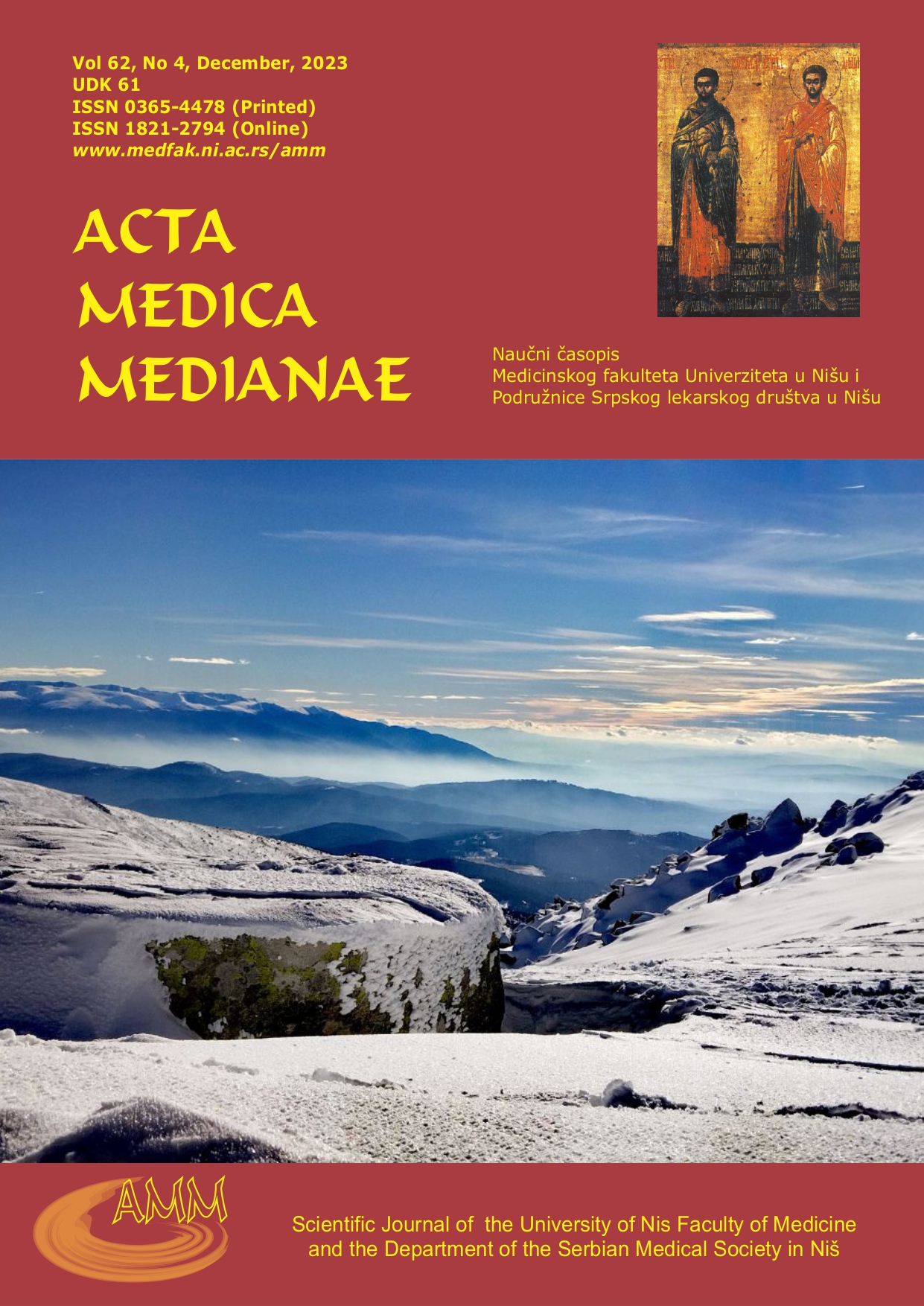FREQUENCY OF MALNUTRITION IN PATIENTS WITH INTRAORAL CARCINOMA
Abstract
Malnutrition, or insufficient or poor nutrition, represents a lack of basic nutrients in a human organism. Being incapable of sufficient intake of nutrients, patients with intraoral carcinomas (ICs) are often affected by malnutrition. One of the most frequently used measures of nutritional status is the body mass index (BMI), an anthropometric parameter. When biochemical parameters are concerned, the level of serum albumin (SA) is the one most commonly employed.
The aim of this study was to analyze the nutritional status of patients with IC by measuring the pre-post-treatment values of BMI and SA and to establish the prevalence of malnutrition in these patients.
In the period from 2015 to 2016, we analyzed the patients with the diagnosis of IC treated at the Department of Maxillofacial Surgery, Clinic of Dental Medicine in Niš. The study sample included 20 patients.
The results of our study support the notion that malnutrition in IC patients should be taken into consideration as one of the key factors of treatment success and complete rehabilitation of IC patients. A multidisciplinary approach and use of nutritional support therapy to correct malnutrition have to become an integral part of everyday practice of all clinics dealing with this pathology.
References
Revasco P, Monteiro-Grillo I, Vidal PM, Camilo ME. Impact of nutrition on outcome. prospective randomized controlled trial in patients with head and neck cancer undergoing radiotherapy. Head Neck 2005; 27(8): 659-68. [CrossRef] [PubMed]
Tan CSY, Read JA, Phan VH, Beale PJ, Peat JK, Clarke SJ, et al. The relationship between nutritional status,inflammatory markers and survival patients with advanced cancer. a prospective cohort study. Support Care Cancer 2015; 23(2): 385-91. [CrossRef] [PubMed]
Ida M, Tachiiri Y, Sato M, Kawaguchi M. Neutrophil-to-lymphocyte ratio as indicator to severe complication after pancreaticoduodenectomy or distal pancreatectomy. Acta Anaesthesiol Scand 2019; 63(6): 739-44. [CrossRef] [PubMed]
Petrers TT, van Dijk BAC, Roodenburg JLN, van der Laan BFAM, Halmos GB. Relation between age, comorbidity and complications in patients undergoing major surgery for head and neck cancer. Ann Surg Oncol 2014; 21(3): 963-70. [CrossRef] [PubMed]
Genther DJ, Gourin CG. Effect of comorbidity on short terms outcomes and cost of care after head and neck cancer surgery in the elderly. Head Neck 2015; 37(5)¬: 683-93. [CrossRef] [PubMed]
Bao X, Liu F, Lin J, Chen Q, Chen L, Chen F, et al. Nutritional assessment and prognosis of oral cancer patients: a large-scale prospective study. BMC cancer 2020; 20(1): 146. [CrossRef] [PubMed]
Boruk M, Chernobilsky B, Rosenfeld RM, Hae-El G. Age as prognostic factor for complications of majoe head an neck surgery. Arch Otolaryngol Head Neck Surg 2005; 131(7): 605-9. [CrossRef] [PubMed]
Du H, Liu B, Xie Y, Liu J, Wei Y, Hu H, et al Comparison of different methods for nutrition assessment in patients with tumors. Oncol Lett 2017; 14(1): 165-70. [CrossRef] [PubMed]
Eskander A, Kang S, Tweel B, Sitapara J, Old M, Ozer E, et al. Predictors of complications in patients receiving head and neck free flap reconstructive procedures. Otolaryngol Head Neck Surg 2018; 158(5): 839-47. [CrossRef] [PubMed]
Kubrak C, Olson K, Jha N, Jensen L, McCargar L, Seikaly H, et al. Nutrition impact symptoms key determinants of reduced dietary intake,weight loss, and reduced functional capacity of patients with head and neck cancer before treatment. Head Neck 2010; 32(3): 290-300. [CrossRef] [PubMed]
Matthews TW, Lampe HB, Dragosz K. Nutritional status in head and neck cancer patients. J Otolaryngol 1995; 24(2): 87-91. [PubMed]
Rathod S, Gupta T, Ghosh-Laskar S, Murty V, Budrukkar A, Agarwal J. Quality-of-life (QOL) outcomes in patients with head and neck squamous cell carcinoma (HNSCC) treated with intensity-modulated radiation therapy (IMRT) compared to three-dimensional conformal radiotherapy (3D-CRT): evidence from a prospective randomized study. Oral Oncol 2013; 49(6): 632-42. [CrossRef] [PubMed]
Ravasco P. Nutrition in Cancer Patients. J Clin Med 2019; 8(8): 1211. [CrossRef] [PubMed]
Robbins KT, Favrot S, Hanna D, Cole R. Risk of wound infection in patients with head and neck cancer. Head Neck 1990; 12(2): 143-8. [CrossRef] [PubMed]
Shruthi P, Ahmed J, Sujir N, Shenoy N, Ongole R. Evaluation of malnutrition and quality of life in patients treated for oral and oropharyngeal cancer. ScientificWorldJournal 2021; 9936715. [CrossRef] [PubMed]
Tsai YT, Lai CH, Huang TH, Hsieh CC, Huang EI, Lee YC, et al. Association of malnutrition with postoperative complication risk aftervcurative surgery for oral cancer. Observational study. Medicine (Baltimore) 2020; 99(52): e23860. [CrossRef] [PubMed]
van der Berg MGA, Rasmussen-Conrad EL, van Nispen L, van Binsbergen JJ, Merkx MAW. A prospective study on malnutrition and quality of life in patients with head and neck cancer. Oral Oncol 2008; 44(9): 830-37. [CrossRef] [PubMed]
Yanni A, Dequanter D, Lechien JR, Loeb I, Rodriguez A, Javadian R, et al.Malnutrition in head and neck cancer patients .¬Impacts and indications of prophylactic percutaneous endoscopic gastrostomy. Eur Ann Otorhinolaryngol Head Neck Dis 2019; 136 (3S): S27-33. [CrossRef] [PubMed]

